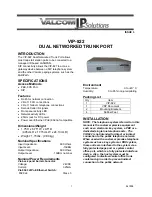
7. GLOSSARY AND ACRONYMS
tocol (SNMP) is an
Internet-standard protocol
for managing devices on IP networks
. Devices
that typically support SNMP include routers,
switches, servers, workstations, printers, mo-
dem racks, and more. It is used mostly in net-
work management systems to monitor network-
attached devices for conditions that warrant ad-
ministrative attention. SNMP is a component of
the Internet Protocol Suite as defined by the In-
ternet Engineering Task Force (IETF). It con-
sists of a set of standards for network manage-
ment, including an application layer protocol, a
database schema, and a set of data objects.
SSH
Secure Shell (SSH), sometimes known
as Secure Socket Shell, is a UNIX-based com-
mand interface and protocol for securely getting
access to a remote computer. It is widely used
by network administrators to control Web and
other kinds of servers remotely. SSH is actually
a suite of three utilities – slogin, ssh, and scp
– that are secure versions of the earlier UNIX
utilities, rlogin, rsh, and rcp. SSH commands
are encrypted and secure in several ways. Both
ends of the client/server connection are authen-
ticated using a digital certificate, and passwords
are protected by being encrypted.
TCP
The Transmission Control Protocol (TCP)
is one of the core protocols of the Internet proto-
col suite (IP), and is so common that the entire
suite is often called TCP/IP. TCP provides reli-
able, ordered, error-checked delivery of a stream
of octets between programs running on comput-
ers connected to a local area network, intranet
or the public Internet. It resides at the transport
layer.
Web browsers use TCP when they connect to
servers on the World Wide Web, and it is used
to deliver email and transfer files from one loca-
tion to another.
UDP
The User Datagram Protocol (UDP) is one
of the core members of the Internet protocol suite
(the set of network protocols used for the Inter-
net). With UDP, computer applications can send
messages, in this case referred to as datagrams,
to other hosts on an Internet Protocol (IP) net-
work without prior communications to set up spe-
cial transmission channels or data paths. The
protocol was designed by David P. Reed in 1980
and formally defined in RFC 768.
URL
A uniform resource locator, abbreviated
URL, also known as web address, is a spe-
cific character string that constitutes a refer-
ence to a resource. In most web browsers, the
URL of a web page is displayed on top in-
side an address bar. An example of a typi-
cal URL would be
http://www.example.com/
index.html
, which indicates a protocol (http), a
hostname (www.example.com), and a file name
(index.html). A URL is technically a type of uni-
form resource identifier (URI), but in many tech-
nical documents and verbal discussions, URL is
often used as a synonym for URI, and this is not
considered a problem.
VPN
A virtual private network (VPN) extends a
private network across a public network, such as
the Internet. It enables a computer to send and
receive data across shared or public networks
as if it were directly connected to the private net-
work, while benefiting from the functionality, se-
curity and management policies of the private
network. This is done by establishing a virtual
point-to-point connection through the use of ded-
icated connections, encryption, or a combination
of the two.
A VPN connection across the Internet is similar
to a wide area network (
WAN
) link between the
sites. From a user perspective, the extended net-
work resources are accessed in the same way as
resources available from the private network.
VPN server
see
VPN
.
VPN tunnel
see
VRRP
VRRP protocol (Virtual Router Redun-
dancy Protocol) allows you to transfer packet
routing from the main router to a backup router
118
09-05-16
LUCOM GmbH * Ansbacher Str. 2a * 90513 Zirndorf * Tel. 09127/59 460-10 * Fax. 09127/59 460-20 * www.lucom.de
w
w
w
.luco
m.d
e
inf
o@lucom
.de
















































